Ivar’s Seattle
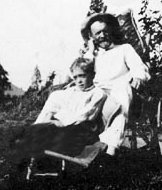
Ivar Haglund was a towering figure in Seattle. He had the unofficial titles Mayor of the Waterfront or King of the Waterfront. His folk singing, radio and television appearances, seafood restaurants, memorable commercials and pranks are part of Seattle’s folklore. Despite his famous “Keep Clam” motto, Haglund’s personality was the polar opposite of his slogan. He was a master of turning opportunities into high profile publicity stunts. This author became interested in Ivar’s story while researching his role in the history of KJR radio (click HERE to read that article).
Ivar, the son of immigrants, was born in Seattle in 1905. His dad was Swedish, a baker by trade, and a real estate investor on the side. Ivar’s mother was Norwegian. Haglund had no memories of his mom. She passed away, a victim of stomach cancer, prior to his third birthday.
Ivar graduated from the University of Washington School of Business Administration in 1928. He planned to become a stock broker. Then the Great Stock Market Crash of 1929 hit, leading to the Great Depression, and his career plans sunk with the stock market. Fortunately for Ivar, he’d received an inheritance from his late father; therefore, he and his wife were better prepared than the average American to endure the near economic collapse of the country.

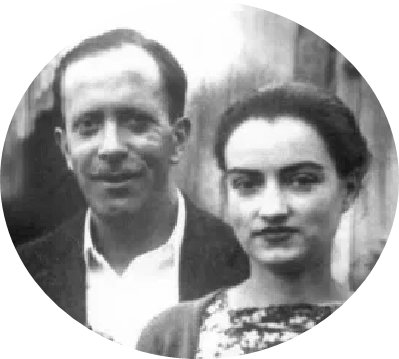
It was during the Great Depression (1929-1933) that Haglund married his first wife Maggie. In the depression years, neither Ivar nor Maggie sought subsistence jobs. The newlyweds lived frugally, without access to very much cash, but they had considerable assets thanks to Ivar’s inheritance. They resided on the beach at Alki Point in a home built on land Ivar’s maternal family had purchased from Seattle pioneer David “Doc” Maynard in 1869.
Haglund also inherited rental houses from his dad. Regular payments from the tenants provided a modest but steady income. At a time of national economic upheaval and out of control crime — bootlegging, loan sharking, and murderous bank robbers the likes of Bonnie & Clyde and John Dillinger shooting it out with G-men — Ivar and Maggie were able to escape much of the misery.
Haglund had played the guitar and the ukulele since he was in grade school. As a student at the UW, he was a tenor in the glee club. Throughout his lifetime, Ivar’s main interest in music was collecting and performing Pacific NW folk songs. He was an expert on the genre and could perform 200 songs from memory.
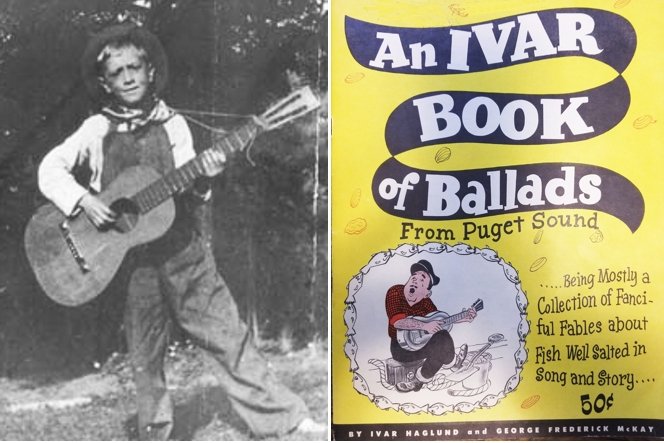
Broadcasting & Old Folkies
Radio Comes to Puget Sound
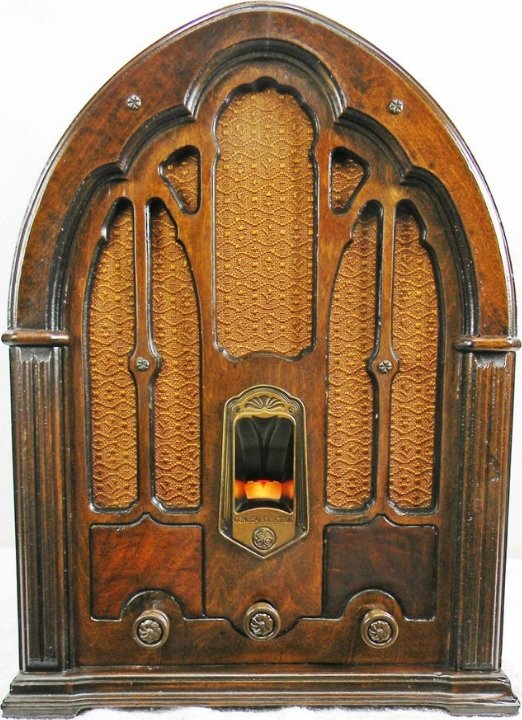 Radio broadcasting was in its infancy in the bleak days of the not so great depression. President Franklin Roosevelt spoke to the American people through his Fireside Chats. A number of classic Golden Age radio shows featuring drama, comedy and music debuted in that era. Ivar listened to Seattle radio and was impressed with the new medium’s potential to entertain. He hoped to host a show where he’d play guitar, sing folk tunes and tell stories. During the depression and in the years leading up to the Second World War, Haglund pursued a career in radio. When the U.S. entered WWII, Ivar supported the war effort by taking a job at Boeing’s B-17 bomber aircraft manufacturing plant.
Radio broadcasting was in its infancy in the bleak days of the not so great depression. President Franklin Roosevelt spoke to the American people through his Fireside Chats. A number of classic Golden Age radio shows featuring drama, comedy and music debuted in that era. Ivar listened to Seattle radio and was impressed with the new medium’s potential to entertain. He hoped to host a show where he’d play guitar, sing folk tunes and tell stories. During the depression and in the years leading up to the Second World War, Haglund pursued a career in radio. When the U.S. entered WWII, Ivar supported the war effort by taking a job at Boeing’s B-17 bomber aircraft manufacturing plant.A Little Help for His Friends
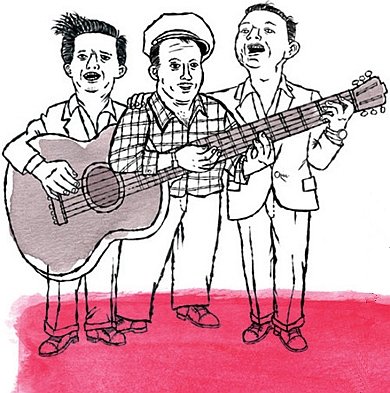
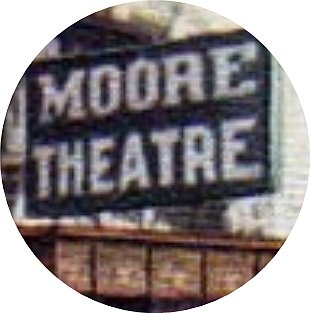 In 1942, Haglund performed at Seattle’s Moore Theater as part of a salute to Earl Robinson, a left wing Seattle songwriter. Based on his early friendships, it’s ironic that Ivar became one of Seattle’s most recognizable and beloved capitalists. Even his wife Maggie was described as having “Marxist” leanings. Remarkably, Haglund dodged the notoriety and career setbacks that befell many of his folk singing contemporaries in those days of the second Red Scare.
In 1942, Haglund performed at Seattle’s Moore Theater as part of a salute to Earl Robinson, a left wing Seattle songwriter. Based on his early friendships, it’s ironic that Ivar became one of Seattle’s most recognizable and beloved capitalists. Even his wife Maggie was described as having “Marxist” leanings. Remarkably, Haglund dodged the notoriety and career setbacks that befell many of his folk singing contemporaries in those days of the second Red Scare.Ivar Dives into Radio

Haglund put considerable effort into finding a niche in Seattle radio. In the 1930s, he’d appeared on KRSC (later KAYO) and met a young announcer named Don McCune. Periodically, he’d performed on other radio stations including KOL and KIRO. One of his KIRO broadcasts was historically significant: In 1941, he hosted a show on the day KIRO upped its power to 50,000 watts.
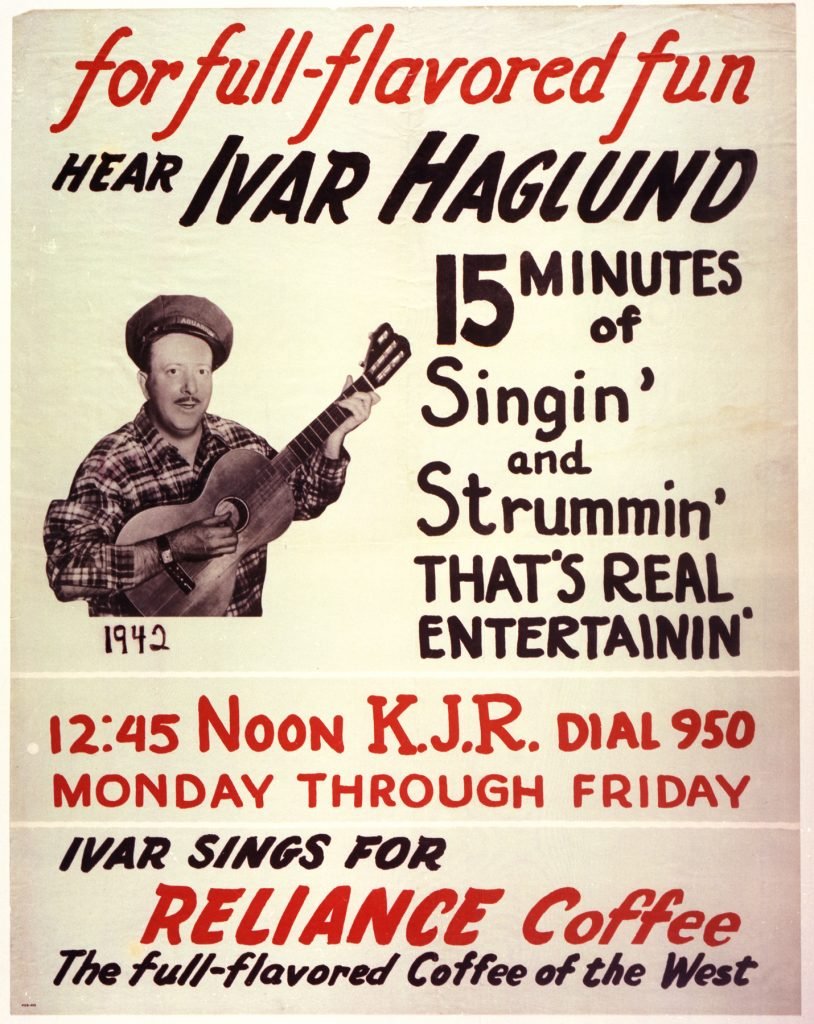
Haglund had a lucky break in 1940. KJR host Morrie Alhadeff needed a fill-in guest ASAP. Ivar was a logical choice — an amicable folk singer who owned a small waterfront aquarium and a fish & chips bar. With Alhadeff in a bind, Ivar grabbed his guitar and showed up at the studio at the appointed hour.
Haglund’s humor and songs resonated with radio listeners and he became a sought after talent in Seattle. The KJR flyer (see photo) indicates that by 1942 station management had offered Ivar a daily 15 minute show that highlighted his Singin’ and Strummin’.
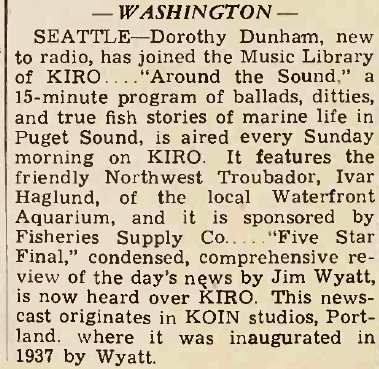
Haglund’s radio career boomed moving into the mid-’40s. Both KIRO (see Radio Daily article) and KJR ran his Sunday program called Around the Sound. As the show’s theme song, Haglund chose a lesser known northwest folk tune titled The Old Settler. He loved the ending, a line about being “surrounded by Acres of Clams.” The old chestnut was Ivar’s signature song thereafter. Not coincidentally, in 1946 his first full service restaurant was named Acres of Clams.
In 1959, Haglund and his friend, author and folk songwriter Jim Stevens, were interviewed at the UW by Seattle music historian Bob Nelson. Ivar told the backstory to his Acres of Clams (The Old Settler) theme song and followed-up by singing a couple verses. First, you’ll hear from Nelson, then Ivar, and Steven’s voice is heard briefly near the end.
UW interview part 1, Acres of Clams theme song (Run time 1:58)
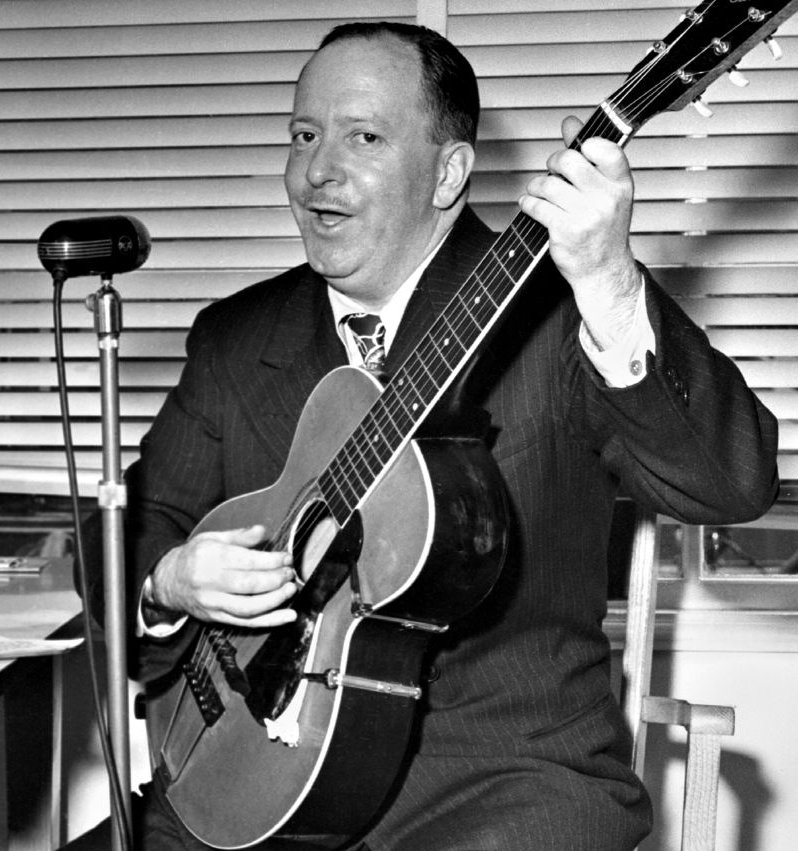
It’s undetermined how much money Haglund earned from his many appearances on radio. Broadcasting was always his avocation, and not his career. He enjoyed performing on the radio, but Ivar always had bigger fish to fry: the waterfront aquarium and the fish bar, then a full service restaurant and finally a chain of eateries. Haglund might have worked on the cheap or for free at least some of the time since his radio appearances provided so much favorable publicity for his other endeavors.
Next up is a 73-year-old homemade recording from one of Ivar’s radio shows. The transcription disc is dated 1948, so it may have been recorded off KJR or KIRO. Haglund recites seafood themed poetry and plugs his Acres of Clams restaurant (which had been around for about two years). Ivar is heard awarding listeners complimentary dinners at Acres of Clams.
Ivar’s Show, Nov. 28, 1948 (Run time 2:00)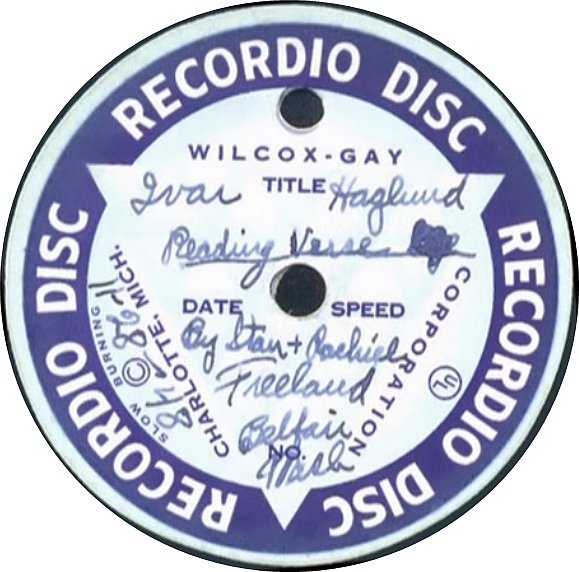
Turn, Turn, Turn
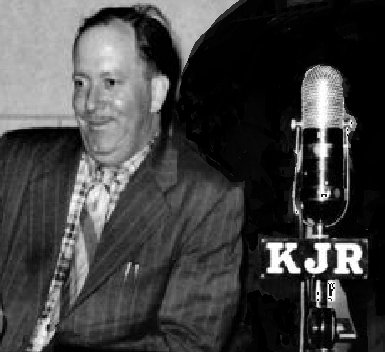
As Ivar’s friend Pete Seeger would sing “to everything (turn, turn, turn) there is a season (turn, turn, turn).” Those verses were true of Haglund’s time on Seattle radio. He was on-the-air for nearly two decades, but by the mid-50s’ his appearances were less frequent. The season for middle-aged folk singing radio hosts was going out like a lamb as Seattle deejays began spinning rock ‘n’ roll records by artists with names like “Elvis” and “Fats.” However, all was well with Ivar. By the time he was phasing out of Seattle radio, he’d already become one of Puget Sound’s most famous and recognizable personalities. And, of course, Ivar didn’t really fade away. He continued to sing the praises of his restaurants in radio and television commercials. Ivar remained a five star celebrity in the northwest until his passing in 1985.
Haglund’s persona is probably best remembered from the quirky and creative television ads that were produced for his restaurants. Yet, in the years before television, his messages were heard exclusively on radio. QZVX has collected several historic audio clips. The first spot ran in 2008, more than 20 years after Haglund had passed. The nostalgic ad, commemorating the 70th anniversary of Ivar’s Restaurants, was produced by Seattle voice-over talent Steve Lawson. The other clips include Ivar plugging his eateries and singing a few sea shanties. Many of the recordings are ancient, and other tracks were recorded not long before Haglund’s death 36 years ago. Clue: The less timbre in Ivar’s voice, the older the recording.
Ivar’s radio spots and ditties (Run time 2:46)
Pictures in the Air
Kid’s Television
Keep Washington Green
UW interview part 2, Keep Washington Green (Run time 2:37)
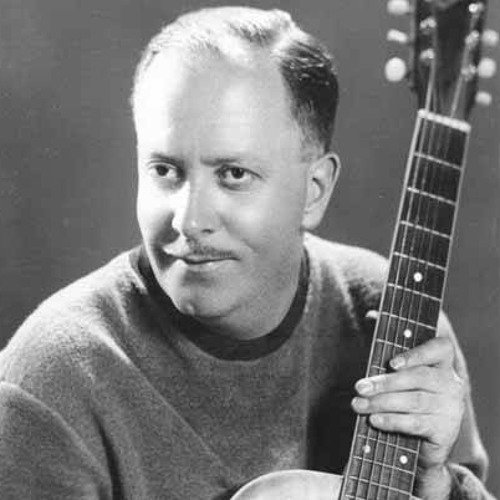
Building a Legend
Fishy Melodies

Despite his success in broadcasting and business, Haglund’s fame grew gradually. He was not an overnight sensation. In 1938, at age 33, the young and relatively unknown folk singer founded Seattle’s first aquarium. At his space on Pier 54, he sat out front dressed as a sea captain. He’d sing and greet passersby. His tunes told of the sea creatures that lived in his tanks. Early aquarium tenants, many of whom Haglund caught in Puget Sound waters, included Barney Barnacle, Herman the Hermit Crab, Terrence the Wood-boring Teredo Worm, Halle the Halibut, Patsy the Seal, and that lovely couple Oscar and Olivia Octopus.
Within Ivar’s aquatic menagerie, Patsy the Seal was the fan favorite. Christmas 1940, Haglund and his hair seal set out to visit Santa Claus at Frederick and Nelson’s department store. Patsy was attired in a pinafore and a lace cap. Ivar wheeled her in a baby carriage. The spectacle drew mega attention as the odd pair traipsed along Seattle’s streets and through Pike Place Market. The event gave an early peek into Ivar’s natural ability to orchestrate publicity stunts.

As the proprietor of an aquarium, Ivar was drawn into the restaurant business by necessity. His visitors, primarily families with children in tow, hoped to grab a quick bite near the aquarium. Always one to oblige, his first fish and chips bar was built near the aquarium entrance. His renowned Acres of Clams stands at the same location (foot of Madison Street on Seattle’s historic waterfront) as that first fish and chips bar. In 1956, as pollution in Puget Sound raised havoc with his sea creatures, Haglund shuttered the aquarium and dedicated his life to becoming Seattle’s most memorable and recognizable restaurateur.

Mogul and His Sock
Ivar was an avid purchaser of real estate. In 1966, he bought Pier 54. Two years later, the Port of Seattle wanted to acquire his pier as the site of a future convention center. Haglund declined the offer. He said he “loved” owning his own pier on the Seattle waterfront
Ivar purchased Seattle’s famed Smith Tower in 1975. It was, and still is, one of Seattle’s most important buildings — the tallest building in the city until the Space Needle was erected for the 1962 World’s Fair. Proving that moguls can be contrary, one of Ivar’s first acts as owner of Smith Tower was to adorn the top of the tower with a giant fish wind sock. The Seattle City Fathers were unhappy and eventually Ivar took down the wind sock. He was quoted by the press as saying that when bureaucrats told him “no,” he just went ahead and did as he wished anyway. Ivar called that attitude the “Seattle Spirit.”
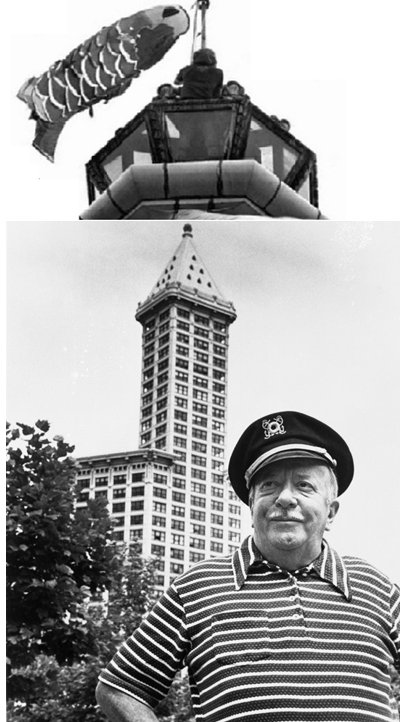
Restaurateur Extraordinaire
Ivar’s restaurant empire continued to grow. By 1969 he was operating Acres of Clams, Broadway Ivar’s on Capitol Hill (established 1951), The Captain’s Table on Elliott Avenue below Queen Anne Hill (established 1956), and the Indian Salmon House on the shore of Lake Union (established 1969). The number of Ivar’s fish bars tripled overnight when he purchased (and renamed) 14 Arthur Treacher‘s fish stands in 1980.
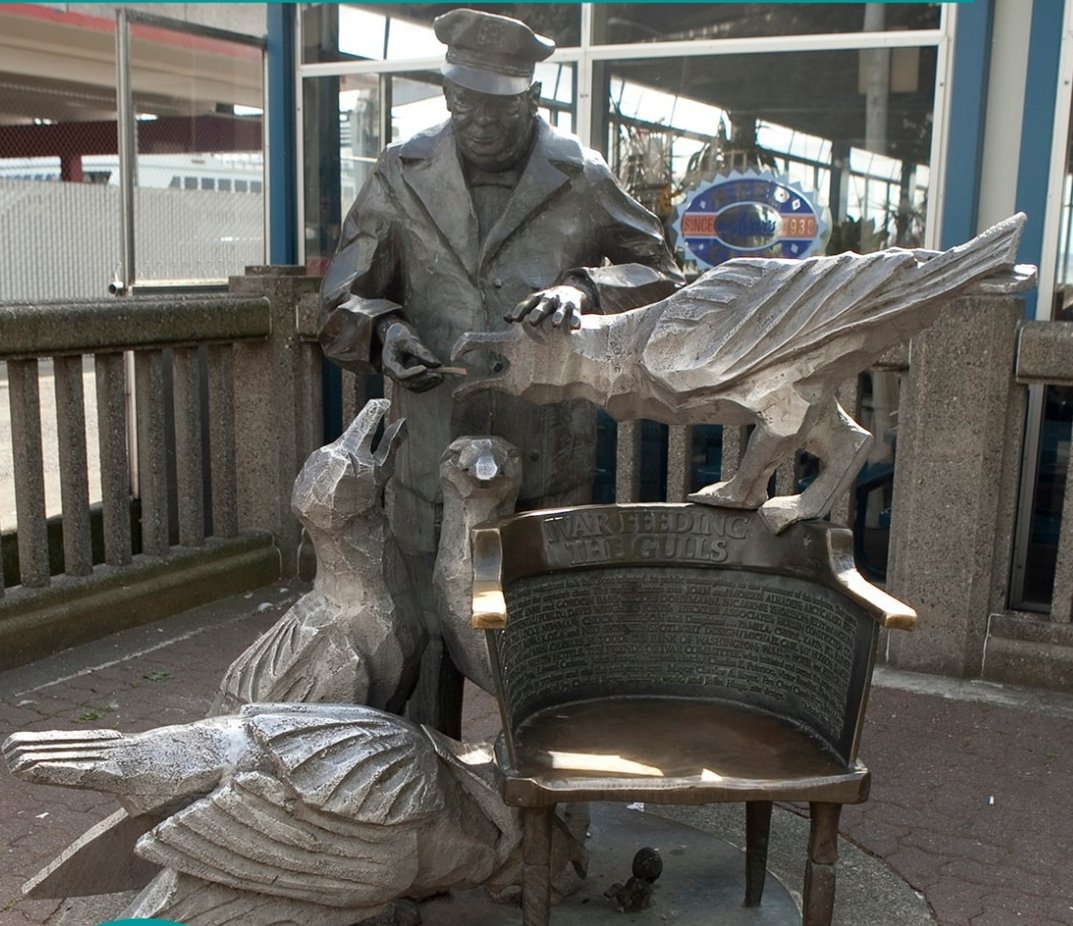
Master Promoter
4th of Jul-Ivar’s
Haglund was community minded. Beginning in the mid-sixties, Ivar’s Seafood Restaurants began sponsoring a Fourth of July fireworks extravaganza 4th of Jul-Ivar over Elliott Bay. That event was a summer tradition in Seattle for 44 years.
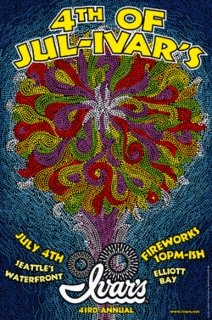
Lap Up the Syrup
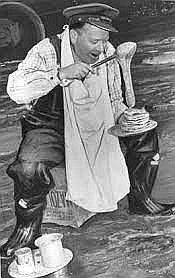
Feed the Sea gulls – Please!
Ivar admired clams the most, and after that came sea gulls. The gulls ate garbage and he said they were the “unpaid guardians” of public health. He always encouraged pedestrians to feed the gulls, ducks and pigeons at Pier 54. Visitors received an Ivar’s-approved recipe for “sea gull health bread.” His neighbor at Pier 56 disliked the messy birds and posted a sign: “Don’t Feed Sea Gulls, Health Regulation.” Haglund counterpunched by posting a sign on his own pier that welcomed sea gulls and sea gull lovers.
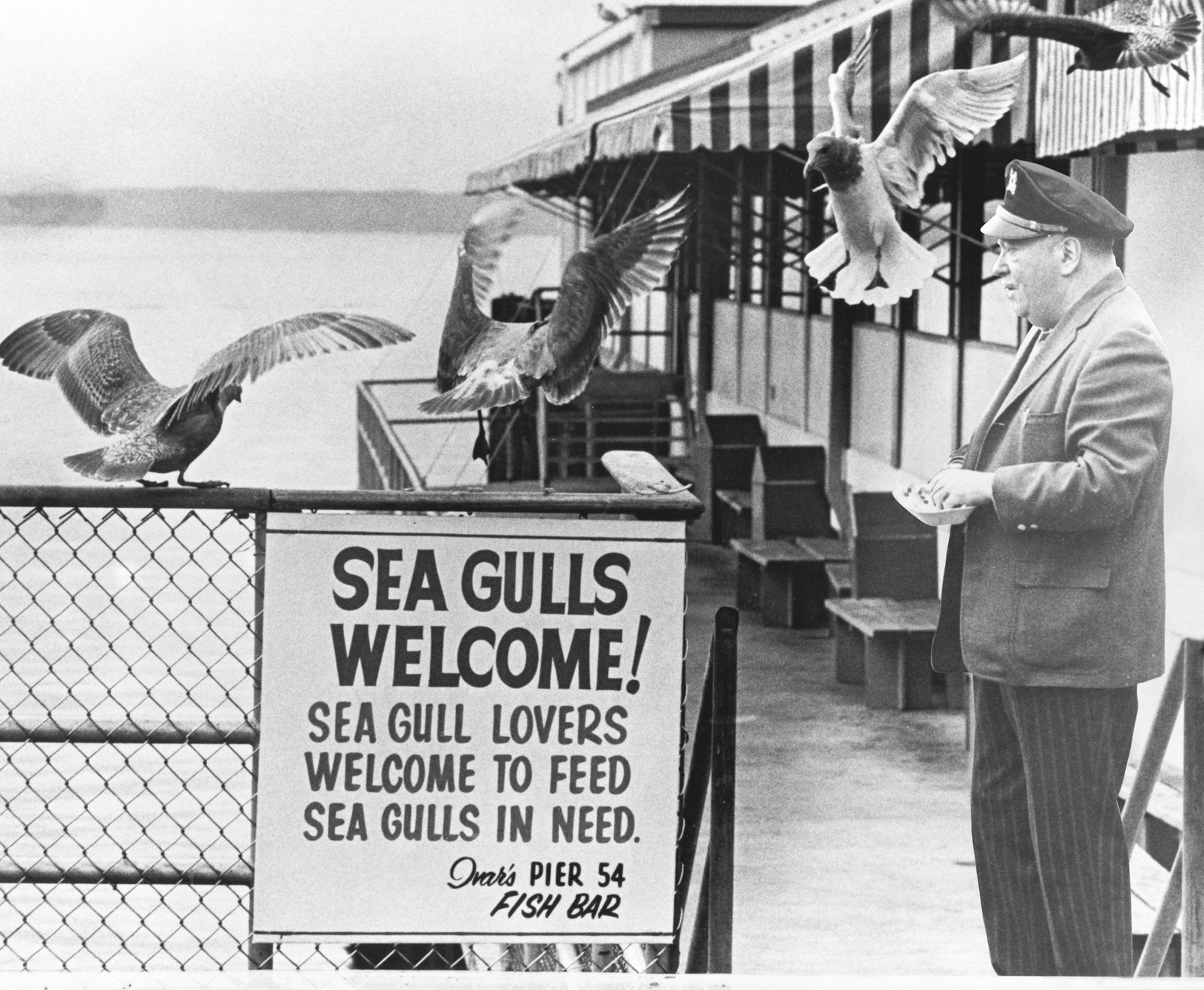
Let ’em Eat Clams
Haglund and a friend founded the Pacific International Free Style Amateur Clam Eating Contest Association. The sole purpose was to sponsor a clam eating contest. Rules were strict: “Any contestant or judge bringing ill repute or question to the contest shall be dealt with in a manner to bring him ignominious humiliation. This should be sufficient warning to would-be fixers and cheap tinhorn gamblers”! In the first competition, a Seattle cab driver was crowned the West Coast winner. A braggart from the East Coast crowed that he could easily defeat the West Coast champ. At the 1948 grudge match that followed, Ivar’s guy won on his home turf. Haglund was photographed placing a crown on the head of his undefeated champion.

Stamped for Life
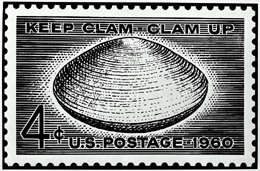 In 1960, Ivar had the U.S. Postal Service worked into a dither. It began when Maine Senator Margaret Chase Smith proposed a stamp commemorating Maine’s sardine industry. Ivar, always a clam lover, sent a wire to Washington senators Warren Magnuson and Henry “Scoop” Jackson: “The sardine has been swimming around witlessly being gobbled up by the smarter fish ever since the Mesozoic Age … Clams keep their mouths shut … and never stick their necks out when the enemy is around.” Then he proposed printing an official clam stamp. Ahead of the game, he and a printer friend created thousands of authentic looking clam stamps. They sent samples to Magnuson’s office in D.C. Included was a sappy note: “A clam stamp would bring in funds for a ‘guided mussel’ program.” Senators Smith, Jackson and Magnuson were photographed with the competing stamps. The picture was published around the country and Ivar Mania continued unabated in the Pacific NW. (In checking U.S. Post Office records, it seems that to this day there has yet to be an official clam stamp or a sardine stamp.)
In 1960, Ivar had the U.S. Postal Service worked into a dither. It began when Maine Senator Margaret Chase Smith proposed a stamp commemorating Maine’s sardine industry. Ivar, always a clam lover, sent a wire to Washington senators Warren Magnuson and Henry “Scoop” Jackson: “The sardine has been swimming around witlessly being gobbled up by the smarter fish ever since the Mesozoic Age … Clams keep their mouths shut … and never stick their necks out when the enemy is around.” Then he proposed printing an official clam stamp. Ahead of the game, he and a printer friend created thousands of authentic looking clam stamps. They sent samples to Magnuson’s office in D.C. Included was a sappy note: “A clam stamp would bring in funds for a ‘guided mussel’ program.” Senators Smith, Jackson and Magnuson were photographed with the competing stamps. The picture was published around the country and Ivar Mania continued unabated in the Pacific NW. (In checking U.S. Post Office records, it seems that to this day there has yet to be an official clam stamp or a sardine stamp.)
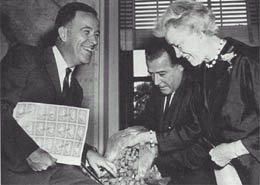
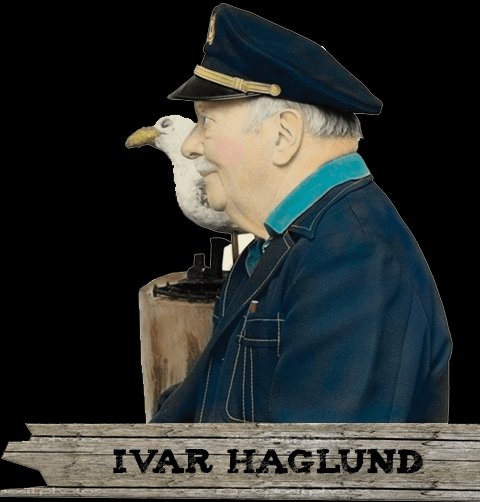
Prologue: None of the names have been changed to protect the innocent. The phony clam stamp made the national news for the last time when Ivar was publicly busted by U.S. Postal Inspectors for selling the remainder of the clam stamps at his restaurant gift shop. The postal service bullies confiscated and burned all of the unsold clam stamps and the plates they were printed from. A bureaucrat in the northwest once described Haglund as never “intentionally” breaking the law, but he went on to say the popular restaurateur didn’t worry much about “bending the rules” either.
Haglund’s personality and humor were keys to his success. Many of the Ivar’s Seafood Restaurant TV ads were created by ad agencies and they have been aired on Seattle television over the years. Despite the appeal of all the highly visual clam themed ads, some of the most appealing commercials featured Ivar speaking to his customers. He amused and entertained by singing silly ditties and employing puns: “Cultured clam” was turned into “clam culture.” The Acres of Clams restaurant was the place “Where Clams and Culture Meet.” He assured viewers: “Ivar’s loves customers; customers love Ivar’s.”
Archival TV ads that featured Ivar are difficult to find. I have located a few of his TV appearances and commercials. Some of the video clips date back to the 1970s. Obviously none of them are post 1985 since that’s when Haglund passed.
The Reluctant Politician
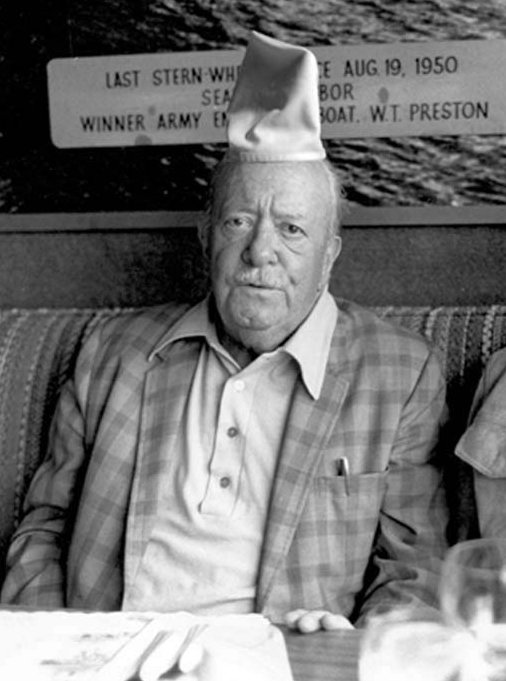
Keep The World Clam!
The legacy of Ivar Haglund and his seafood restaurants is well preserved in the abundance of memorable Ivar’s TV commercials that have blanketed the Pacific NW for decades. Ivar’s Restaurants has their own in-house creative team and many of the classic ads also involved the Seattle ad agency, Heckler and Associates. The reel below includes some of Ivar’s Restaurants most famous ads, ones that will tickle a memory gland. These classics date back to the 1970s, with most of them from the ’80s and a few from the early ’90s. The final ad is from 2009 and it’s famous in itself as the shortest ad (at half a second) to ever run in a Super Bowl broadcast.
A Chowderhead Reveals His Secret
In 1963, Post-Intelligencer columnist Emmett Watson interviewed Ivar. He asked Haglund to reveal his secret to success in business. Ivar’s reply was simple, “Sometimes it’s just sitting and thinking. Sometimes it’s just doing nothing, instead of getting in there and lousing things up.” One of the restaurateur’s greatest insights was his understanding that allowing talented and capable people to run his business was often the best move.

Ivar Haglund died of a heart attack on January 30, 1985, while getting out of bed. In his 79 years, he had been married twice (first to Maggie in the depression years and then to Opal in 1967). Both marriages ended in divorce and he had no children or heirs. In his Last Will Ivar gave a few gifts to friends. But the bulk of his estate, including revenue from his ownership interests in 15 restaurants, was split evenly between Washington State University’s School of Hospitality Business Management program and his alma mater, the University of Washington School Of Business. After all the paperwork was completed, each University was bequeathed $5.2 million (equivalent to 12.8 million each in 2021).
Ivar’s Will specified that his employees should have the opportunity to buy the business. He believed people who had been in his employ would carry on his traditions. It appears that theory was correct. Ivar’s Seafood Restaurant’s sponsorships have continued on with park concerts, school events, tournaments, and the big Fourth of July spectacular ran clear into 2008.
The Show Goes On
The off the wall and funny ads have carried on even after Ivar has left us. The early-90s blockbuster Dances with Clams themed TV ads were huge, although the campaign was briefly halted when Hollywood complained of infringement — the similarity to “Dances with Wolves,” the movie. After a short hiatus, Ivar’s corporate decided the heck with it and put the ads back on the air with few if any repercussions.
The company Ivar built now operates three full service restaurants: Acres of Clams, The Salmon House, and Ivar’s at Mukilteo Landing. The number of Ivar’s fish bars has expanded to northwest cities including Spokane, Bellingham, and Portland. Restaurant staff has grown three times over in the 35 years since Haglund’s death. (Sidebar: In the era of Covid-19, and the accompanying restrictions, many of the Ivar’s restaurants are closed. Hopefully they will be able to resume operations as the situation improves).
Ivar’s Seafood Restaurants has published Ivar’s Seafood Cookbook and Ivar’s Puget Sound Clam Chowder is sold at grocery stores and specialty food retailers worldwide. Ivar’s management refers to distributing the authentic chowder as their way of “trying to help keep the world clam.”

Back From The Past

New management has kept Ivar’s tradition for pranks and wackiness alive, but not without controversy. A 2009 media campaign promoted the thought that 50 years previously Ivar had placed full sized underwater billboards in the harbor. He did so “expecting an increase in submarine traffic into Seattle.” The promotion got lots of people’s imagination working overtime. But it all turned out to be an elaborate spoof that some viewers had swallowed hook, line and sinker. Not everybody was pleased with the outcome. Regardless, Ivar’s Seafood Restaurants was still a major force in Seattle marketing even though Haglund had died nearly 25 years before.
For anyone intrigued by the “Underwater Billboard Campaign,” this next video link includes two teaser spots from the 2009 ad campaign. In the following segment from Evening Magazine on KING 5, it’s revealed that the entire promotion was a good-natured hoax (to see the ads and the Evening Magazine episode click HERE.)
Thank yous and credits
Steve Lawson’s Friendly Voice Production (click HERE)
History link.org and Paul Dorpat (click HERE)
Pacific NW Folklore Society.org (click HERE)
Seattle Channel.org — Eccentric Seattle Video Episodes (click HERE)
Presently editor and historical writer with QZVX.COM in Seattle. Former radio broadcaster and radio station owner, 1970-1999. Journalism and speech communications degrees. I enjoy researching articles and online reporting that allows me to meld together words, audio and video. P.S. I appreciate and encourage reader comments and opinions.

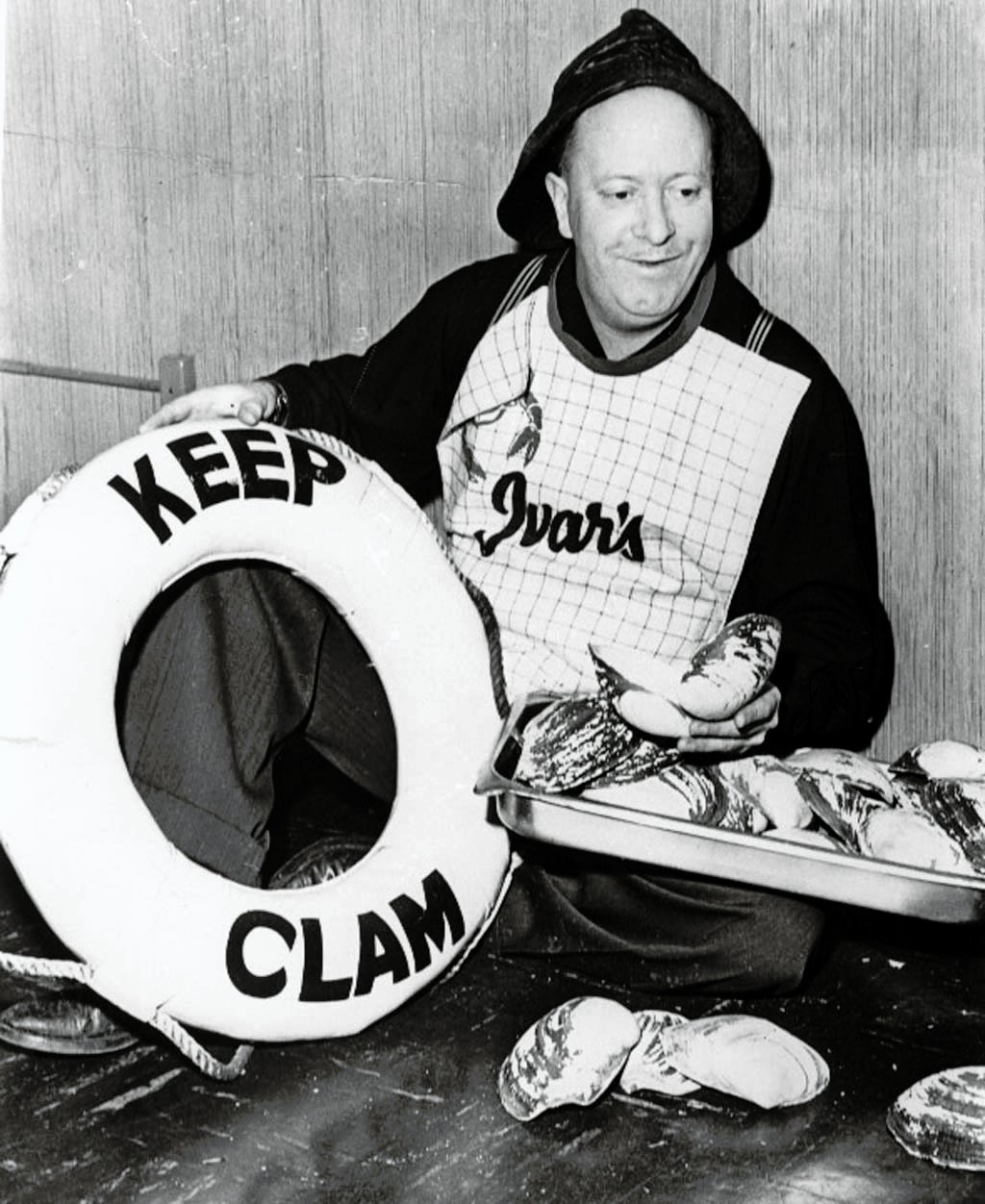
Mike…I did not expect it to be as detailed as it is. But at some point I decided that if anyone is researching Ivar it would be nice to have so much of his life in one spot complete with photos and audio and video. This is a major part of what I like about online posts. You can do more than any other medium. Books and newspapers have words and photos but no video or audio. Film has the video, audio and photos but instead of reading at your own pace, a narrator does it all at his or her pace. Radio can play the audio, but no photos. With blogging you can conveniently present it all and take the reader back into history. Instead of imagining what something looked or sounded like.. the reader has it all at his or her fingertips.
Mike…thanks for sharing it. I had been working on that one and all the media edits since Christmas. But I am happy how it turned out as a one stop synopsis on Ivar in radio, TV and in restaurants.
These days you pay a fin and a gill to have a plate of Ivar’s fish and chips.
There is one up here at the mall. I will have to try it but seldom go in the mall. I have been to Ivar’s Seattke a few times but probably back when he was alive.
Steve…cool story. In the many years I was at SRO, I had free movie passes. Those kinds of perks do boost one’s popularity,
Steve ~ I fondly recall (while at KMPS in the ’80s) my friend singer Gail Davies (whom I’d 1st met in ’71 while at KBFW-B’ham & she’d not yet found fame & fortune in Nashville) would often return to the PNW to visit family & friends in her hometown of Port Orchard. Gail would stop by to connect with me at the KMPS Pike Place Market location and the 1st thing she’d want to do is head for Ivar’s down on the waterfront to get fish ‘n chips with plenty of tartar sauce. She absolutely loved her Ivar’s! I was always delighted to accompany her because my personal belief is there’s no better fish ‘n chips than Ivar’s!
I will have to give the fish and chips a try. I really like his chowder that I know.
I can’t vouch for the fish ‘n chips at their franchise stores, but they’re still top-notch at the walk-up Fish Bar at Ivar’s Salmon House on north Lake Union and Ivers at Pier 54 in Seattle. Yummy yummy!
Jay…well when the mall fish bar opens I am going to go there and if it does not measure up I will send you the bill.
Jay, I agree with you. Ivar’s Fish ‘n Chips are the best, and especially when surrounded by dozens or maybe hundreds of seagulls down on the pier.
Undisputed facts: 1) Ivar’s Clam Chowder is also the best. 2) Those gray and white seagulls are the most beautiful birds in the world.
Enthralling anecdote: In 1991, second ex and I were in town for a week and stayed high above it all at Stouffer’s Hotel at 8th & Madison. Every morning, we shared our room service breakfast with the same seagull. The window barely opened, just enough to extend a couple of fingers with some bacon or sausage.
Dick…I have found sea gulls appreciative of any scraps I gave them. Some will catch it in the air.
Doing PMD at KBRD, the morning guy & I had little laminated cards that allowed us, and an unlimited number of guests, to order anything we wanted from any Ivar’s Seafood Bar in the Puget Sound area (except beer). We were VERY popular at lunchtime around the station! We each did live 60s every day for about 3 months!